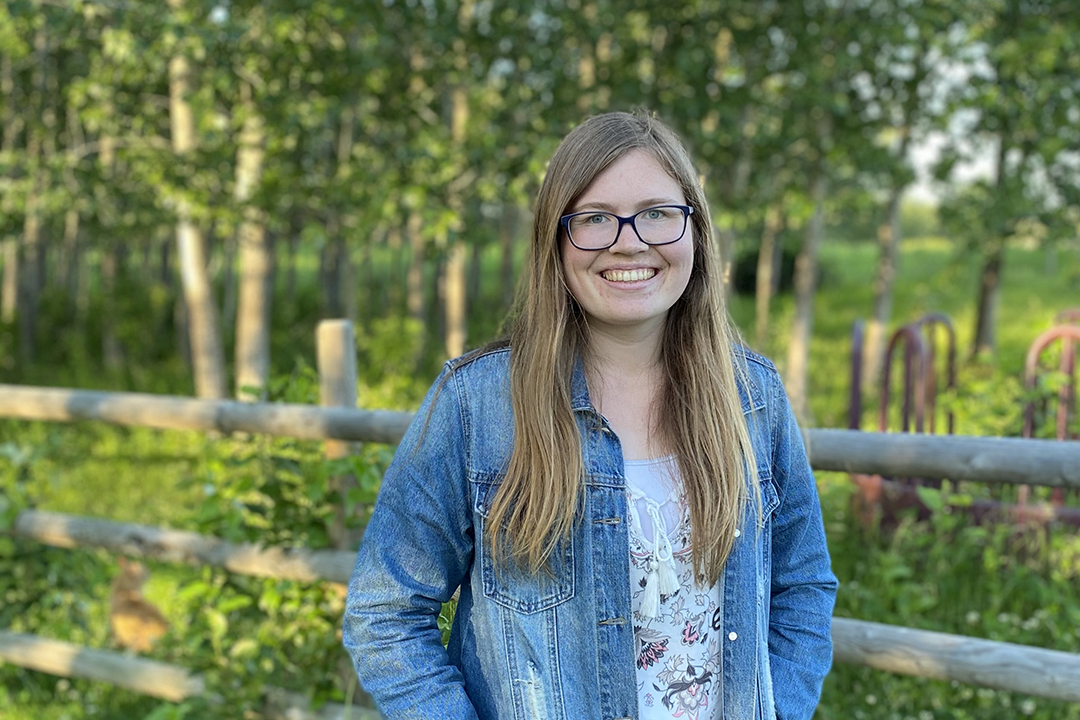
Animal health career clicks for vet student
Hope Skorlatowski had always been involved with the dogs on her family’s acreage in Cold Lake, Alta., but once she enrolled in canine agility classes at the age of 11, she began to view dogs differently.
By Lynne Gunville“I saw the classes at our community registration day and signed up with our six-year-old Labrador-retriever cross,” recalls Skorlatowski, a first-year student at the Western College of Veterinary Medicine (WCVM). “I was hooked after the first class, and my obsession only grew when I went to my first competition.”
Those initial experiences sparked a fascination with animal behaviour that has since expanded to include other species including horses and even cats — Skorlatowski clicker-trained her three cats as a COVID-19 quarantine project earlier this year.
By the time Skorlatowski was 12, she was pet sitting for families in the region, and she eventually began to offer basic training in areas such as house training and obedience. She also socialized puppies to new environments and cared for geriatric pets.
During her years as a member of Cold Lake’s PAWSitive Dog Sports, Skorlatowski acquired a basic understanding of animal behaviour as she interacted with the other club members, attended clinics and researched science-based training techniques.
Once she began assisting with the classes and realized that she and the participants shared many similar issues with their dogs, Skorlatowski became more comfortable offering advice and helping people to reach their goals.
“I got most of my experience from training my own pets,” says Skorlatowski. “My first puppy that I raised by myself was fear reactive and extremely anxious about new situations. I was forced to learn how I could help her to get over some of her fears. I also learned how important socialization is in young puppies.”
Skorlatowski also worked as a wrangler at Penner Horseback Adventures Ltd. in Cold Lake, and before long, she was riding her own horse around the ranch.
“I enjoyed getting paid to ride my horse every day,” says Skorlatowski. “And my horse loved having a job. He thrived when he was able to explore all day.”
Year after year Skorlatowski dressed up as a veterinarian for her school’s career day. She knew that she wanted to work with animals, and by the time she was in high school, she was focused on attending the WCVM and embarking on a career in veterinary medicine.
To get clinic experience, Skorlatowski began volunteering at Cold Lake Veterinary Clinic. As she helped with the day-to-day clinic tasks, Dr. Kaitlyn Cockerill (WCVM ’14) offered encouragement and support.
Skorlatowski was particularly impressed that the clinic staff were constantly innovating and changing their handling procedures to improve animal welfare and reduce their patients’ stress.
She also spent a summer working at the Lakeland Humane Society where the staff helped her to get more experience handling animals by saving any medical-related jobs for her.
Now that Skorlatowski has begun her first year of vet school at the WCVM, she’s enjoying the chance to get even more hands-on experience in the animal handling labs — especially with species that she hasn’t worked with before. She’s already joined an animal behaviour and welfare club and is on the lookout for webinars that will further her knowledge of animal behaviour and training. She’s also planning to pursue her latest interest — cowboy dressage.
After graduation, Skorlatowski looks forward to a career in small animal medicine and hopes to work in a practice with ties to a local animal shelter. She’s confident that her experiences with training a variety of species and personalities will benefit her as a student and as a practitioner.
“My experiences have given me a diverse background and experience with a lot of different species as well as personalities. I’ve seen what a happy dog looks like and what a stressed dog looks like, and I can adjust how I interact with the animal accordingly.”
